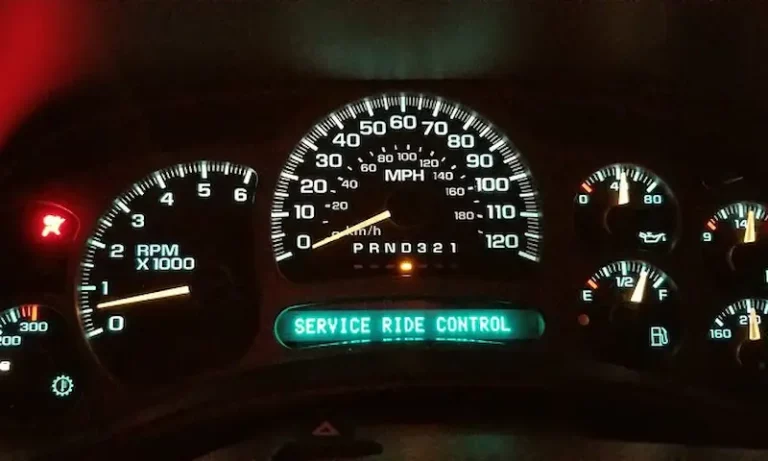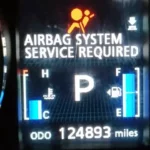If you are getting the Service Ride Control, the ECU or dedicated processor has flagged something wrong with the suspension system. The causes may vary depending on the suspension deployed in the vehicle.
For instance, the warning message in an air suspension system is often related to a damaged air suspension compressor.
In a suspension control system that uses an electronic suspension control (ESC), faults picked up by the ESC could trigger the “service ride control” warning message.
This article will look at the meaning of service ride control, how it works, the causes of the error, and recommend fixes to help you.
What is Service Ride Control?
A “service ride control” is a warning message that will come up when something is wrong with the suspension control system. Issues with the suspension compressor and ESC majorly trigger the warning light.
What is a suspension control system? It is a mechanical system comprising many aspects like springs or shock absorbers, compressors, control modules, and axles. All these parts combine to maintain the vehicle’s height and alignment regardless of the driving condition.
Within the system, there is the Electronic Suspension Control (ESC). It controls each shock absorber (each wheel has four shock absorbers). It can control the way the vehicle rides and make changes depending on the condition of the road.
Also, the ESC system allows the vehicle to adapt to the current driving condition quickly. It has to ability to change the suspension characteristics within milliseconds.
The ESC controls inputs, including the vehicle’s speed, body-to-wheel displacement, pitch, and steering angle.
In addition, the system collects output from various sources, including sensors. In turn, the output provides information on the driving and road conditions. The ESC then makes decisions based on the collected output.
Specific sensors feed the ESC system with information allowing it to make quick suspension change. The suspension includes accelerometers and wheel hub sensors.
The accelerometer measures the changes in the speed or direction of the vehicle. On the other hand, the wheel hub or wheel speed sensor is located on each wheel and monitors the speed at which the wheels turn.
Once the ESC system detects a fail-soft-action (a failed ECS system action) or any other malfunctions, the system will send a message to the Engine Control Unit. The ECU will display one of three warning messages; Speed limited, Service Suspension System, and Shock Inoperative.
In addition, the air suspension compressor can also cause the service ride control to come up in an air suspension system. The compressor feeds the air spring with air, which helps maintain the right height for the vehicle. Once damaged, the ECU would notify the driver through a warning message.
What are the causes of Service Ride Control?
Some factors could cause the service ride control to come up. The primary factor is anything that hinders the ESC from working correctly. Also, a damaged air suspension compressor is a significant cause of the warning sign in an air suspension system.
Below are the causes of “service ride control.”
1. ESC detects a problem
The ESC system controls parts of the suspension system to ensure the vehicle maintains good driving conditions. In acting the ESC, the system can detect part of the suspension system that is not working correctly.
Once the damaged part of the suspensor affects the ESC from operating properly, the system will trigger some warning message. One of the warnings is the service ride control.
2. Failing compressor
The air suspension compressor is a small compressor that pumps air into the air spring. Once this is done, the proper vehicle height is maintained regardless of the vehicle’s load.
Also, the air suspension compressor only works in an air suspension system. You will not find the compressor in all types of suspension systems.
When the compressor is damaged, the ECU cannot adjust the vehicle to its predetermined height. The computer system will then trigger the warning message to come up.
3. Mechanical suspension issues
There are other internal components that, when damaged, the warning message “service ride control” will come on. For instance, the shock absorber; is meant to dampen the compression and rebound of the suspension and the springs.
When the shock absorber is damaged, the sensor will notice it and send a signal to the ESC system. Once the system gets the signal, it notifies the driver through a warning message.
4. Damaged sensors
When the sensors that the ESC works with get damaged, the warning message could also be triggered. The ESC majorly works with accelerometers and wheel hub sensors.
If any of the sensors are damaged, it becomes impossible for the ESC to determine when the suspension needs to be adjusted. The ESC will also alert the driver that there is something wrong with the suspension through the warning message.
How to Fix a Service Ride Control
The first step to fixing a service ride control is a proper diagnosis. Since a few factors could cause the issue, you could use an OBDII scanner to scan the sensors and the system for faults that could trigger the warning message.
You could physically inspect the various factors that could cause the issue and then fix it.
Below are ways to fix the service ride control.
1. Diagnose and fix ESC-detected issues
When the ESC detects an issue, it is stored on the ECU, so you can quickly diagnose it with a scanning device. You only need to plug the ECU into your vehicle and scan it.
Scan for error codes or other forms of alerts that could be related to the suspension system. Once you find it, you must properly interpret if it is an error code and fix the suspension problem.
2. Replace the damaged sensor
Also, use an OBDII scan tool to test the related sensor to the ESC, which is the accelerometers and wheel hub sensors. The scan tool will tell you which is functioning by testing the sensor by displaying available or unavailable.
Once the exact damaged sensor is determined, locate the sensor using the owner’s manual. Once it is found, replace the sensor with the same type as the damaged one.
3. Replace the failing air suspension compressor
The air suspension compressor is under the hood along the driver’s side. It is just under the washer fluid tank.
To replace the air suspension compressor, turn on the ignition and then go ahead to release the air pressure. Turn the ignition off and disconnect the air line from the compressor and any other connection.
Raise the car at the front end and remove the black plastic panel and compressor from the vehicle. Push in the new compressor and connect all the necessary connections.
4. Repair mechanic suspension issue
A repair like this deals with repairing or replacing damaged parts of the suspension. In a case like this is recommended that a professional fixes the issue. The expert can diagnose adequately, find the damaged part, and then fix or replace it.
Final Thoughts
Diagnosis is an important aspect of fixing a service ride control. The issue can be easily fixed once the problem’s cause is found. Where people miss it is not properly diagnosing the warning message and then end up replacing or trying to fix a perfectly working part of the suspension.




